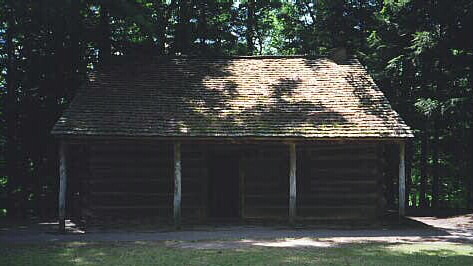
The Capture of Mary Jemison
Mary Jemison was born in 1743 on the tiny sailing vessel called the Mary William as her family were moving to the New World from Ireland.
She was living with her family in western Pennsylvania in 1758, when a group of Shawnee warriors and French soldiers captured her during the French and Indian War. Mary was fifteen years old at the time of her capture. Her parents and three of her younger siblings were killed at the time of her capture. Her two older brothers managed to escape.
Mary was purchased by a group of Senecas and taken back to Ohio. The Senecas adopted the teenager as a replacement for a young Indian Warrior who had been slain.
In a ceremony Mary Jemison was welcomed into the family with the following expression of Welcome and given the name Dehgewanus meaning "Two Fallen Voices."
"Deh-ge-wa-nus has come. Let us receive her with joy. She is handsome and pleasant. Oh, she is our sister. Gladly we welcome her here in the place of our brother."
She was treated with the same high regard accorded to women of the Iroquoise tribes.
Mary helped with the daily chores of bringing in wood and fresh water, rinsing the cooking utensils in the stream, caring for the younger children, gathering nuts and berries, and helping in the fields.
Mary and her sisters would move to spend the winter months downriver at the spot where the Scioto joins the broad Ohio River.
Dehgewanus married She-nin-jee, a member of the Delaware tribe, when she was 17 years old. They had two children, but only one survived. Soon after the second child was born, Dehgewanus and Sheninjee began a trip to Sheninjee's homeland along the Genesee River in New York. Sheninjee died along the way, but Dehgewanus continued on, carrying her young child all the way, and arrived a widow. The New York Senecas made a home for her at Little Beard's Town.

This portrait of Mary Jemison by Carlos Stebbins is courtesy of Letchworth State Park, NY
After a year of grief and Mary had at last begun to heal, a Dutchman by the name of John Van Sice made it known his intentions of returning Mary to the English Authorities. Mary went into hiding for 3 lonely days and nights. Finally sullen and angry Van Sice left.
Scarely a week after Mary's return an elderly warrior of the tribe told Mary's brother that he was not in agreement with the judgement of keeping Dehegewanus with them and that he intended to return Mary to the English Authorities himself. Mary's Indian brother "Young King" said he would kill Mary before he saw her turned over to the English, just so the old man could buy rum. Mary had to go into hiding for the second time in a week. But the young brother won and the old warrior left for Niagara without Mary.
Dehgewanus eventually married again, this time to a Seneca Warrior, Hogadawa, and had six or seven more children. She became a member of Seneca society. In 1797 she was awarded 18,000 acres some of which she rented to hungry white families.

This is the cabin Mary built herself, for her daughter, Nancy, in 1800. It stood in the Gardeau Flats area along the Genesee River. William Letchworth had it moved to it's present location on the Council Grounds of Letchworth State Park. Mary also built herself a nearby cabin where she lived for 35 years.
In 1811 Mary's second husband died, and not long afterwards all 3 of her sons were tragically killed.
Mary became known as "the White Woman of the Genesee" and remained in New York for the rest of her life.
Toward the end of 1823 when Mary was 80, she told her life's story to James Everett Seaver, who wote it down and published it.
Dehgewanus died on September 18, 1833 at the age of 90. Today her grave is at Letchworth State Park. It is marked by a statue showing her as she arrived in the Genesee country carrying her first-born son on her back.

This story is update with facts based on information from a book by Jeanne LeMonnier Gardner
My Native Index